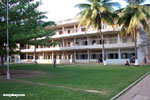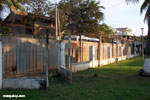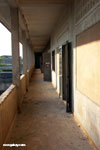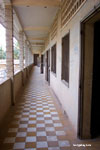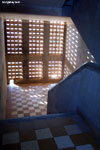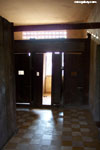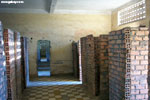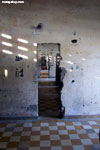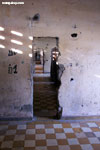
|
CAMBODIA: S-21 | Phnom Penh | Angkor Wat | Bayon | Ta Prohm |
|
Cambodia Pictures
Phnom Pehn All images are the property of Rhett Butler, copyright 2003. Contact me regarding use and reproduction. From 1975-1979 roughly 20,000 Cambodians were executed by the Khmer Rouge at S-21 Prison in Phnom Penh, Cambodia. Seven prisoners survived. S-21 is now the Tuol Sleng Museum of Genocide.
Recommended travel guides on Cambodia: 
S-21 - from Wikipedia S-21 was a prison camp located in Phnom Penh, Cambodia, used by the Khmer Rouge from its rise to power in 1975 to its fall in 1979. It was also known as Tuol Sleng ('hill of the poisonous tree' or 'hill of guilt'). History Formerly the Tuol Svay Prey High School, named after a Royal ancestor of King Sihanouk, the five buildings of the complex were converted in 1975 into a prison and interrogation centre. The Khmer Rouge renamed the complex to Security Prison 21 (S-21) and construction began to adapt the prison to the inmates: The buildings were enclosed in barbed electrified wire, the classrooms converted into tiny prison and torture cells and all the windows were covered with iron bars and barbed wire to prevent escape of the prisoners. From 1975 to 1979, an estimate of 14000 to 15000 people were imprisoned at S-21 (some estimates suggest a number as high as 20000). The prisoners were selected from all around the country, and usually were former Khmer Rouge members and soldiers, accused of traitorous behaviour or treason. Even though the vast majority of the victims were Cambodian, the prison population included members of other nationalities, including Vietnamese, Thai, Pakistanis, Laotians, Indians, Americans, British, Canadians, New Zealanders, and Australians. The whole family of the prisoner (including women, children and babies) was also often brought en masse to be interrogated and later exterminated at the Choeung Ek extermination centre. In 1979, the prison's horrors were uncovered by the invading Vietnamese army. In 1980, the prison was reopened as a historical museum, the Tuol Sleng Museum, memorializing the genocide committed by the Khmer Rouge regime. The museum is opened to the public, and receives an average of 50 visits every day. Life in the prison The quality of life of the prisoners at Tuol Sleng was terribly harsh. Upon arrival at the prison, the prisoners were photographed and required to give a complete biographical information. After that, they were forced to strip naked, and all their possesions were removed. The prisoners were then taken to their cells. Those taken to the smaller cells were shackled to the walls. Those who were held in the large mass cells were collectively shackled to long pieces of iron bar. The prisoners had to sleep in the cold floors, while still shackled. The prison had very strict regulations, and severe beatings were inflicted upon any prisoner who tried to disobey. Almost every action had to be approved by one of the prison's guards. Likewise, health conditions were awful. The unhygienic living conditions caused skin diseases, lice, and other ailments, and few of the inmates ever received any kind of treatment. Tortures and extermination The torturing system at S-21 was designed to make prisoners confess to whatever crimes their captors charged them with (much like the methods of the Medieval Inquisition). Prisoners were tortured with electric shocks, searing hot metal instruments, hanging and other horrible devices. Although many prisoners died from this kind of abuse, killing them outright was discouraged, since the Khmer Rouge needed their confessions. The vast majority of S-21 prisoners were probably innocent of the charges against them and their confessions lies produced by torture. It was only a matter of time before the torture would break even the strongest of prisoners. After the interrogation, the prisoner and his/her family were taken to the Choeung Ek extermination centre, fifteen kilometers from the centre of Phnom Penh. There, they were brutally killed by being battered with iron bars, pickaxes, machetes and many other makeshift murder weapons. Out of the roughly 15000 prisoners at the prison, there are only seven known survivors. Staff of the prison The prison had a staff of 1720 people. Of those, approximately 300 were office staff, internal workforce and interrogators. The other 1400 were general workers. Several of these workers were children taken from the prisoner families. Most of them were trained and brainwashed to become brutal guards. The chief of the prison was the infamous Khang Khek Leu (also known as Comrade Duch), a former mathematics teacher who worked closely with Khmer Rouge leader Pol Pot. Rules of Tuol Sleng These were the rules of Tuol Sleng:
The photographic archive The Khmer Rouge required the prison's staff to make a detailed dossier of all the prisoners. Included in the documentation was a photograph. Since the original negatives and photographs were separated from the dossiers in the 1979-1980 period, most of the photographs remain anonymous today. The photographs are currently being exhibited at the Tuol Sleng Museum and at Cornell University, Ithaca, New York, USA. S21: The Khmer Rouge Killing Machine S21: The Khmer Rouge Killing Machine is the title of a 2003 film by Rithy Panh, a Cambodian-born filmmaker who lost his family when he was 11. The film features a group of two S-21 survivors and a dozen former Khmer Rouge fighters -prison guards, interrogators, a doctor and a photographer-. The focus of the film is the difference between the feelings of the survivors, who want to understand what happened at Tuol Sleng to warn future generations, and the former jailers, who cannot escape the horror of the genocide they contributed to create. |
what's new | rainforests | tropical fish | for kids | search | about | copyright & use | contact |
Copyright Rhett Butler 1994-2012 Pictures were taken by Rhett A. Butler, copyright 2008. While these photos are the property of mongabay.com, it may be permissible to use them for non-commercial purposes (like powerpoint presentations and school projects), provided that the images are not altered in any form. Please read this for more details. If you are interested in using an image in a publication please contact me. Mongabay.com is a free resource. |

